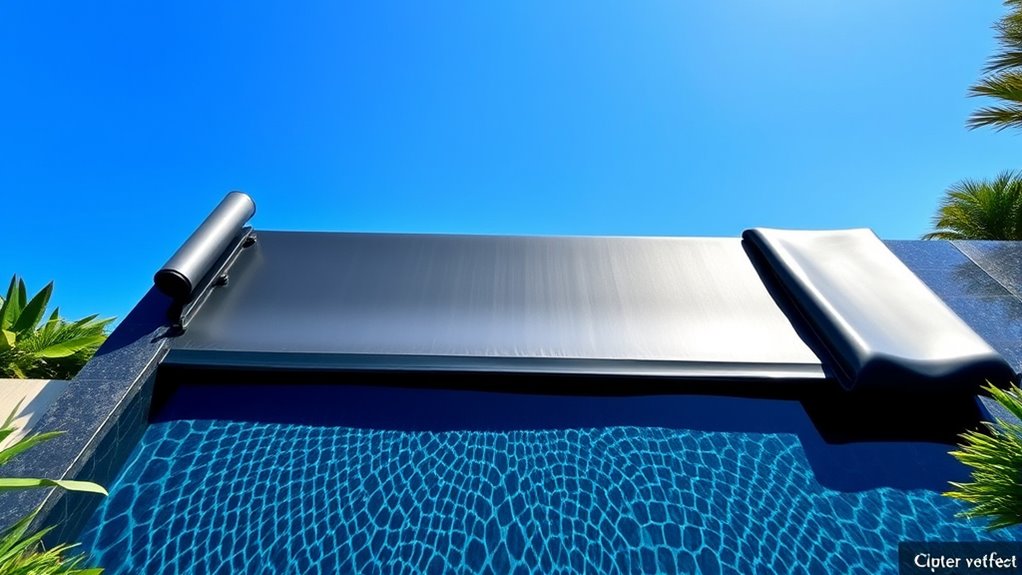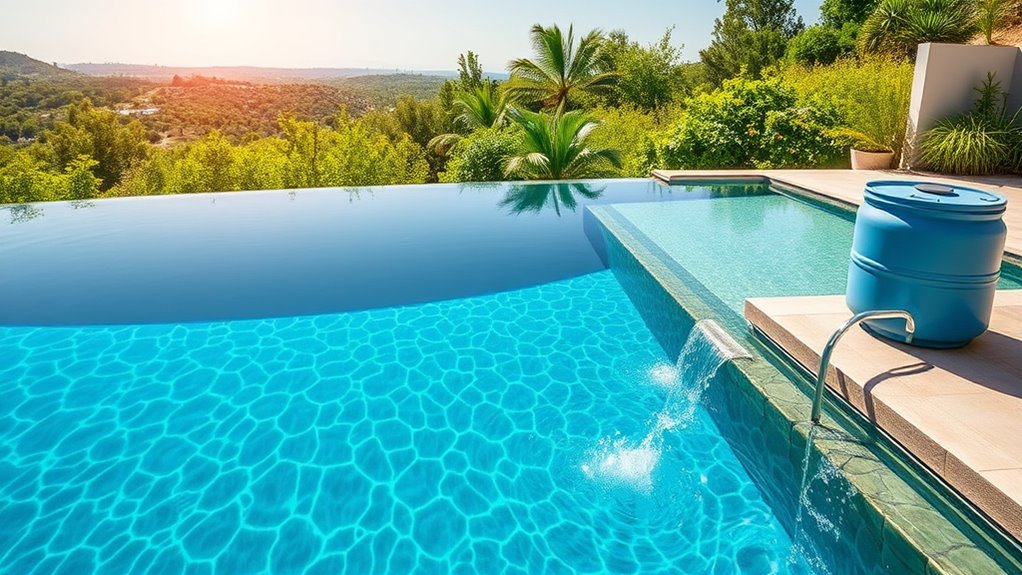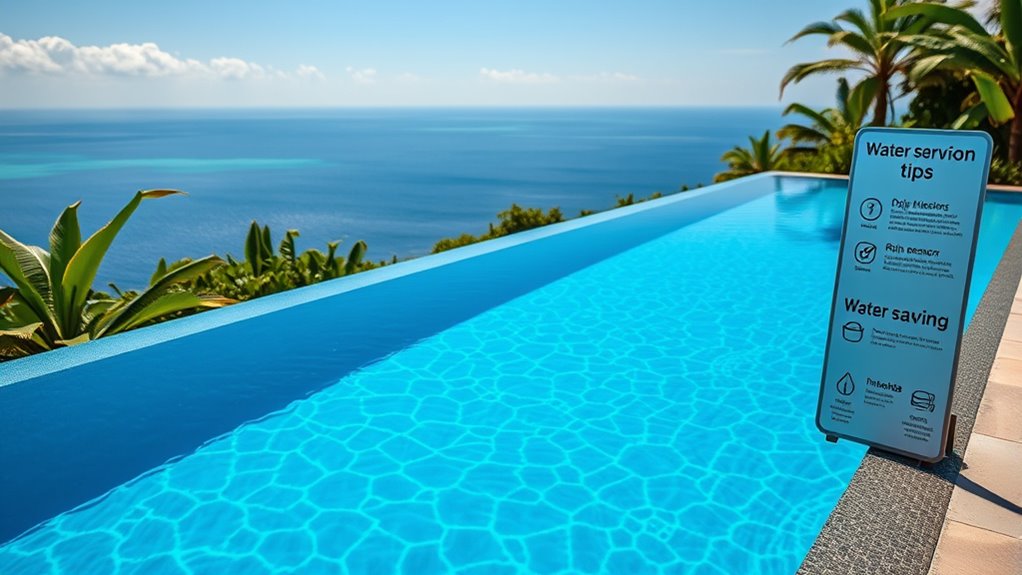To conserve water in your infinity pool, regularly check for leaks and fix them promptly to prevent waste. Use a snug-fitting pool cover to reduce evaporation, especially during non-use or windy days. Optimize your filtration system with efficient pumps, and make certain proper water circulation. Consider eco-friendly features like rainwater harvesting and smart auto-fill devices. Monitoring and adjusting water levels keeps your pool functioning smoothly while saving water. Want more tips for sustainable pool management? Keep exploring to learn additional strategies.
Key Takeaways
- Use a snug, high-quality pool cover to significantly reduce evaporation when the pool is not in use.
- Install auto-fill systems and rainwater harvesting to maintain water levels efficiently and minimize unnecessary refills.
- Regularly check for leaks and promptly repair any damage to prevent water loss.
- Optimize pump operation with timers and maintain filters to ensure effective circulation without wasting water.
- Adjust water levels carefully using measurement tools to avoid overfilling and unnecessary water consumption.
Regularly Check and Repair Leaks

Leaks can silently drain your pool’s water supply, so it’s essential to regularly inspect your infinity pool for any signs of leaks. Look for wet spots around the pool’s structure, uneven water levels, or damp patches on the surrounding deck. Pay attention to the pool’s equipment, such as pumps and filters, for any leaks or drips. If you notice a sudden drop in water level that can’t be explained by evaporation, it’s time to investigate further. Repair leaks promptly to prevent water waste and more significant structural damage. Use appropriate sealants or replace damaged tiles or liners as needed. Regular maintenance and swift repairs not only conserve water but also extend your pool’s lifespan, saving you money in the long run. Incorporating preventative maintenance into your routine can help identify potential issues early before they become costly problems.
Use a Pool Cover to Minimize Evaporation

Using a pool cover is one of the most effective ways to reduce water loss from evaporation. When you cover your infinity pool, you create a barrier that traps moisture and prevents it from escaping into the air. This simple step can cut water evaporation by up to 90%, saving you significant amounts of water over time. Make sure to choose a cover that fits your pool snugly and is easy to remove and replace. Using a cover also helps keep debris out of the water, reducing the need for cleaning and chemical use. Keep your pool covered when you’re not using it, especially during hot, windy days. Proper evaporation control techniques are essential for sustainable water management, especially in large pools. This small habit can lead to substantial water conservation and lower maintenance costs.
Optimize Water Circulation and Filtration

Properly optimizing your pool’s water circulation and filtration makes certain the water stays clean and healthy while minimizing unnecessary water loss. When your pump runs efficiently, it prevents stagnation and reduces the need for frequent refills. To achieve this, consider these steps:
- Set your pump on a timer to run during off-peak hours, ensuring continuous flow without waste.
- Regularly clean and backwash filters to maintain optimal filtration performance.
- Adjust the flow rate so water circulates effectively without overworking the system.
Imagine clear, sparkling water moving smoothly through the system, removing debris and keeping chemicals balanced. Efficient circulation not only conserves water but also extends the life of your pool equipment.
Implement Water-Efficient Pool Features

Incorporating water-efficient features into your infinity pool can considerably reduce water consumption and long-term costs. One effective option is installing a smart auto-fill system that refills your pool only when necessary, preventing unnecessary water loss. Consider using high-efficiency pumps and filters designed to minimize water and energy use. Additionally, incorporating a rainwater harvesting system allows you to collect and reuse rainwater, reducing reliance on municipal sources. Using pool covers also plays a crucial role; they significantly decrease evaporation when the pool isn’t in use. Opt for durable, eco-friendly materials for pool fixtures and fittings that require less maintenance and last longer. These features work together to optimize water use, cut costs, and promote sustainable pool ownership. Implementing Juice Cleanse and Detox practices can further support an eco-friendly lifestyle by encouraging healthier choices and reducing environmental impact.
Monitor Water Levels and Adjust Accordingly

Regularly monitoring your pool’s water level ensures it stays within the ideal range, preventing waste from overfilling or damage from low levels. To do this effectively, follow these steps:
- Check the waterline: Visually inspect the pool’s edge, ensuring the water is just below the overflow lip.
- Use a measuring stick: Insert it into the water to get an accurate reading of the current level.
- Adjust water volume: Add or drain water as needed, avoiding sudden changes that waste resources.
Maintaining proper water levels not only conserves water but also protects your pool’s pump and filtration system. Regular adjustments keep your infinity pool functioning efficiently and ensure you’re doing your part to save water.
Frequently Asked Questions
How Often Should I Perform Water Quality Testing on My Infinity Pool?
You should test your infinity pool’s water quality at least once a week to guarantee proper chemical balance and safety. If the pool gets heavy use or experiences weather changes, test more frequently, like twice a week. Regular testing helps prevent algae growth, maintains clear water, and minimizes chemical waste. Don’t forget to check pH, chlorine levels, and alkalinity to keep your pool in top condition.
Are There Eco-Friendly Chemicals Suitable for Maintaining My Pool?
Yes, you can use eco-friendly chemicals to maintain your infinity pool. Look for natural or mineral-based sanitizers, such as saltwater systems, which reduce chemical usage. Enzyme treatments break down organic matter without harsh chemicals, and pH adjusters made from natural ingredients help keep water balanced. Always choose products labeled eco-friendly or biodegradable, and follow manufacturer instructions to guarantee safety and effectiveness while minimizing environmental impact.
What Are the Signs of a Hidden Leak in My Infinity Pool?
Your infinity pool might be leaking if the water level drops unexpectedly, like a secret slipping out. Check for cracks, wet spots around the pool, or an unusually high water bill. Listen for odd sounds or see if the skimmer basket fills faster. Regularly inspect the pool’s structure and plumbing. Catching leaks early keeps your pool from becoming a sinking ship, saving water and money in the long run.
Can Solar Heating Reduce Water Evaporation in Infinity Pools?
Yes, solar heating can reduce water evaporation in your infinity pool. By maintaining a consistent, warm water temperature, solar heaters minimize the temperature fluctuations that cause evaporation. Additionally, solar covers trap heat and moisture, further lowering evaporation rates. You should consider installing a solar cover when the pool isn’t in use, as it acts as a barrier against water loss, helping you conserve water and energy effectively.
How Does Local Climate Affect Water Conservation Strategies for Infinity Pools?
Your local climate considerably impacts your water conservation strategies for infinity pools. In hot, dry environments, evaporation rates soar, so you should cover your pool when not in use and install windbreaks. Cooler, humid climates naturally reduce evaporation, allowing for less intensive conservation efforts. Understanding these climate effects helps you tailor your approach, conserving water effectively while maintaining your pool’s beauty and functionality.
Conclusion
By following these water conservation tips, you can substantially reduce your infinity pool’s water usage and help protect our environment. Did you know that a single leak can waste up to 10,000 gallons of water annually? That’s enough to fill a small swimming pool! So, stay vigilant with regular checks, use covers, and optimize your system. Your efforts not only save water but also contribute to a more sustainable future for everyone.









